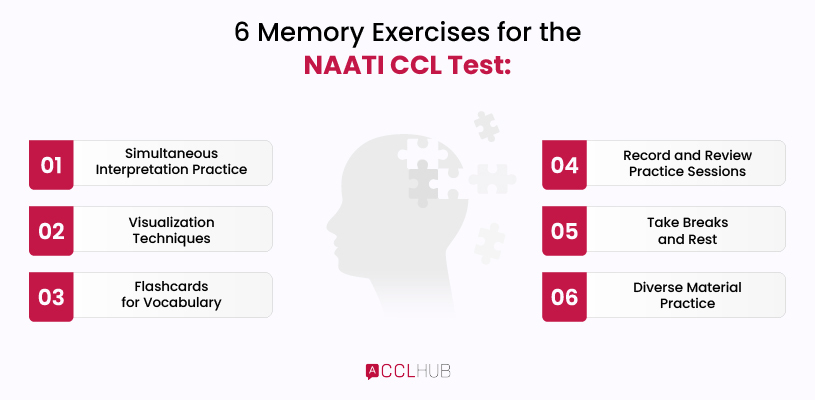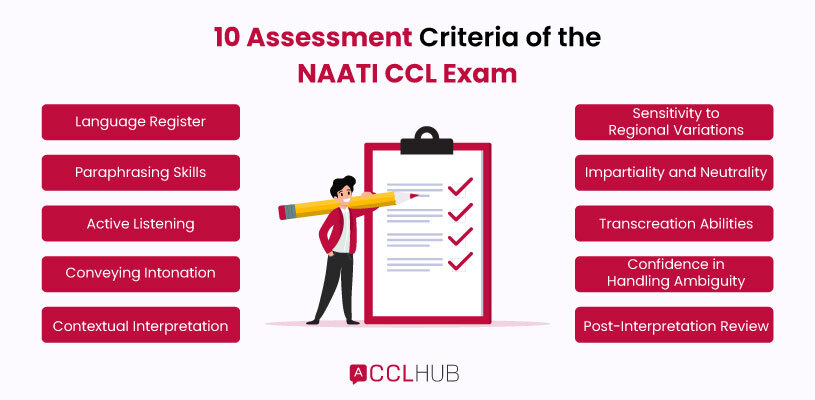
Assessment Criteria of the NAATI CCL Exam
Welcome, esteemed language enthusiasts and individuals aspiring to earn five Australian PR points. Let’s explore ten assessment criteria of the NAATI CCL exam to help you clear the NAATI CCL exam on your first attempt.
Are you prepared to start the journey that could unlock professional opportunities and get you one step ahead in your immigration to Australia? The NAATI CCL test certification grants the opportunity for a career and immigration boost.
Moreover, In this blog, let’s dive deep into the core of the NAATI CCL test, uncovering the ten essential assessment criteria that will help you pass the NAATI CCL exam with your desired score.
✅ Also check out: Pass the NAATI CCL Test in Under One Week
Memory Exercises for the NAATI CCL Test

Before diving into the main content, let’s learn about some memory exercises for the NAATI CCL test. These exercises play a vital role in preparing for the CCL exam, as they enhance an interpreter’s ability to recall and retain critical information during a fast-paced examination.
Moreover, these exercises strengthen memory and aid in honing other essential skills required for successful interpretation. Following are some memory exercises to help your NAATI CCL test journey.
1. Simultaneous Interpretation Practice
Engage in the regular practice of simultaneous interpretation by listening to short audio clips or dialogues in the source language and interpreting them into the target language without pausing. Also, gradually increase the complexity and length of the clips to challenge and improve memory recall.
Similarly, incorporating regular practice sessions into your routine is crucial. Allocate dedicated time daily for simultaneous interpretation exercises and utilize diverse materials such as news articles, podcasts, or recorded dialogues.
Furthermore, consider practicing with a partner or joining online language exchange platforms. Engaging in conversations with native speakers or fellow test-takers can simulate real-time scenarios, allowing you to refine your skills in a supportive environment.
Finally, to enhance your performance, pay attention to common themes and scenarios encountered in the NAATI CCL test online and familiarize yourself with topics related to healthcare, education, social services, and everyday interactions. This targeted preparation will better equip you to handle the specific content encountered in the test.
2. Visualization Techniques
After reading or listening to a passage in the source language, close your eyes and mentally visualize the content, attempting to recall as many details as possible. Visualization exercises help you strengthen your memory retention and aid in organizing thoughts for coherent interpretation.
To begin with, picture the words or phrases you are learning. Close your eyes and visualize the concepts in your mind.
Moreover, consider creating a mental “mind map” for different topics. This can help organize information spatially in your mind, making it easier to recall during the test.
Additionally, associate images with specific words or phrases. For example, if you’re learning vocabulary related to technology, visualize gadgets or scenarios involving the use of technology. This association can strengthen your memory and make the learning process more enjoyable.
Practice incorporating visualization into your simultaneous interpretation exercises. As you listen to a passage, visualize the scenes and scenarios described. This aids in understanding the context and enhances your ability to convey the information in the target language accurately.
3. Flashcards for Vocabulary
Create flashcards with source and target language words and phrases. Regularly review and test yourself to reinforce vocabulary retention. Flashcards are particularly effective for learning specialized terminology.
Consistency is key. Set aside a specific time each day to go through your flashcards. Repetition helps reinforce your memory, making recalling vocabulary more straightforward during the test. Make it a routine, like a short daily vocabulary workout.
Likewise, to enhance effectiveness, categorize your flashcards based on themes or topics.
Engage in active recall. Cover one side of the flashcard and try remembering the meaning or translation before checking. This practice strengthens your ability to recall information on the spot, which is crucial during the test.
Additionally, consider incorporating visual elements into your flashcards. Add simple drawings or symbols related to the word to create a visual association. This visual reinforcement can further enhance your memory.
4. Record and Review Practice Sessions
Record your interpretation practice sessions and listen to them later. This self-evaluation allows you to identify areas for improvement and fine-tune your memory recall and interpretation skills.
Likewise, use a recording device, like your smartphone or computer, to capture your practice sessions. This allows you to listen back to your interpretation and identify specific areas where you can enhance your skills.
After recording, take time to review the playback. Listen critically to your pronunciation, fluency, and accuracy. Pay attention to areas where you might need to improve your delivery.
Also, make notes on the phrases that posed challenges. Focus on understanding the context and meaning behind these areas. This step helps you pinpoint specific aspects that require more attention and practice.
Consider sharing your recordings with a study partner or language exchange buddy. Getting feedback from others can provide valuable insights and different perspectives and help you boost your career and life in Australia.
Moreover, repeat this recording and reviewing process regularly, incorporating feedback and making adjustments as needed. Consistent practice and reflection are key to refining your simultaneous interpretation abilities for the NAATI CCL test.
5. Take Breaks and Rest
Now, let’s talk about something crucial for effective NAATI CCL test preparation: taking breaks and getting proper rest. Studying for long periods without breaks can be counterproductive, leading to fatigue and decreased concentration.
Hence, remember that your brain needs time to process and retain information. Plan your study sessions in manageable chunks, such as 25-30 minutes of focused study followed by a short break.
This approach, known as the Pomodoro Technique, helps maintain your attention and prevents burnout.
Furthermore, during breaks, step away from your study materials. Engage in activities that relax your mind, like stretching, taking a short walk, or doing something enjoyable. This allows your brain to recharge and be more ready for the next study session.
Also, consider scheduling longer breaks between study blocks to give yourself a chance to rest more deeply. Taking breaks is not only about physical rest but also about mental rejuvenation. It helps prevent stress and keeps your mind sharp.
Finally, ensure you get sufficient sleep each night. Quality sleep is essential for memory consolidation and overall cognitive function. Aim for 7-9 hours of sleep to support your brain’s ability to process and recall information effectively.
6. Diverse Material Practice
Practice interpreting different types of content, such as news articles, dialogues, speeches, and interviews. Exposure to diverse materials sharpens memory adaptability and prepares you for various scenarios in the exam.
Alright, let’s talk about making your NAATI CCL test preparation more interesting and effective by using diverse materials. Variety in study materials can help you adapt to different topics and scenarios.
Firstly, mix up your study resources. Instead of sticking to one type of material, explore a range of sources. Include newspapers, podcasts, online articles, and dialogues from various contexts. This broadens your exposure to different vocabulary, accents, and themes.
Moreover, Try to cover a spectrum of topics. The NAATI CCL exam can include content from various fields such as healthcare, education, social services, and more. By practicing with diverse materials, you prepare yourself to handle a wide range of subjects during the actual test.
Incorporate materials that reflect real-life situations.
Similarly, consider watching movies, TV shows, or videos in the languages you’re practicing. This exposes you to colloquial expressions, cultural nuances, and different speaking styles, contributing to a well-rounded language proficiency.
Don’t forget to include materials related to the specific language pairs you’re working on. If, for instance, you’re preparing for an English-to-Mandarin test, practice with content that involves English speakers interpreting into Mandarin and vice versa.
10 Assessment Criteria of the NAATI CCL Exam

The NAATI CCL assessment criteria contain information about a comprehensive set of essential skills and attributes you must demonstrate during the NAATI CCL examination.
Without further ado, let’s explore ten assessment criteria of the NAATI CCL exam.
1. Language Register
In the NAATI CCL exam, the language register is an important skill. Slowly adapting to match the context in your practice can infuse your interpretations with authenticity.
Also, whether switching between formal and informal language or employing professional jargon, a keen sense of linguistic appropriateness increases the quality of communication and resonates with both speakers and listeners.
2. Paraphrasing Skills
Demonstrating paraphrasing skills is very important for a proficient interpreter. Effectively rephrasing complex sentences while retaining the essence of the original message ensures smoother communication flow and fosters better understanding among the parties involved.
Also, the ability to condense complex ideas into clear expressions reflects an interpreter’s expertise in navigating challenges.
3. Active Listening
Active listening does not only mean the act of hearing words. It means a profound understanding of the message that is conveyed and the emotional nuances within it.
Furthermore, by attuning yourself to the speaker’s tone and emotions, you can accurately interpret and effectively convey the intended meaning, ultimately enhancing the impact of the communication.
4. Conveying Intonation
The art of conveying accurate intonation is an invaluable skill in interpretation. Mastering the subtle variations in pitch, rhythm, and stress allows interpreters to mirror the source language, preserving the speaker’s emotions.
Also, this adept intonation breathes life into the dialogue, captivating listeners and enabling a more authentic cross-cultural exchange.
5. Contextual Interpretation
NAATI assessors carefully evaluate candidates’ ability to grasp the broader context of the dialogue. Demonstrating insightful contextual interpretation helps interpreters make informed inferences and deliver more accurate and culturally relevant translations.
This skill enriches the communication experience by capturing the intricacies and subtleties that language alone may not convey.
👉 Editors Recommend: Personalized Study Plan for Your NAATI CCL Exam
6. Sensitivity to Regional Variations
Language is a vibrant tapestry of regional variations and dialects, each with unique cultural nuances. Sensitivity to these nuances enables interpreters to make informed choices in their interpretations, showcasing an appreciation for the diverse fabric of language.
Moreover, acknowledging and navigating regional differences with finesse exemplifies a deeper understanding of cultural intricacies.
7. Impartiality and Neutrality
As guardians of communication, interpreters must remain impartial and unbiased. A steadfast commitment to neutrality allows interpreters to convey the intended message without personal influence faithfully.
By upholding this ethical responsibility, they ensure all parties’ voices are equally represented and respected.
8. Transcreation Abilities
Transcreation requires changing mere translation and adapting content creatively while preserving the original impact. Interpreters with exceptional transcreation abilities navigate cultural references, idiomatic expressions, and humor to bridge the linguistic and cultural gap effectively.
Likewise, such skillful transcreation adds an enriching layer to the communication, fostering deeper connections between participants.
9. Confidence in Handling Ambiguity
In real-life scenarios, ambiguity can challenge even the most seasoned interpreters. Practicing and gaining confidence in handling such situations allows interpreters to remain composed and deliver interpretations.
Also, you can build your confidence by going through the assessment criteria of the NAATI CCL exam and clear it easily with the help of CCLHUB.
10. Post-Interpretation Review
Finally, a commitment to continuous improvement drives interpreters to undertake post-interpretation reviews. By thoroughly evaluating their work, candidates identify and rectify any errors or areas for enhancement.
This self-critical approach increases the quality of interpretations and strengthens candidates’ professional growth.
What level of English should you have to pass NAATI CCL?
To pass the NAATI CCL test and earn five Australian PR points, you must score 63 or more overall and at least 29 marks in each dialogue.
Moving on candidates should have a high level of English proficiency. The exam assesses the candidate’s language abilities in the source (English) and target (second) languages. While the focus is on the candidate’s second language, a strong command of English is essential for effective communication during the interpretation process.
Likewise, candidates must demonstrate fluency, accuracy, and comprehension in English to interpret dialogues accurately and convey the meaning of the dialogues, including a solid grasp of grammar, vocabulary, and idiomatic expressions.
Language proficiency in English ensures that candidates can comprehend complex dialogues, paraphrase information effectively, and convey the correct meaning in the target language.
Moreover, it enables candidates to adapt their language register and intonation appropriately, further enhancing the authenticity of their interpretations. Hence, strong proficiency in English is fundamental for passing the NAATI CCL exam successfully.
🔔 Don’t Miss: NAATI Pricing Update 2023 💪💪
Conclusion
In pursuit of five Australian PR points, mastering the ten essential assessment criteria of the NAATI CCL exam can be vital. These criteria guide aspiring interpreters toward success in this language test journey.
To further aid your NAATI CCL journey, CCLHUB is an invaluable online portal for all queries regarding the NAATI CCL Online Test. This comprehensive platform offers various resources to empower candidates throughout their preparation process.
Furthermore, CCLHUB provides NAATI CCL course materials and NAATI CCL mock tests, and free NAATI CCL test samples, helping you assess your proficiency level and identify areas for improvement.
FAQ
Q1: How is the NAATI CCL exam structured?
The NAATI CCL exam consists of two dialogues, where candidates interpret from the source language (English) to the target language and vice versa. Each dialogue is approximately 300 words long, and candidates have a specific time limit to complete their interpretations.
Q2: Is it mandatory to have language credentials to take the NAATI CCL Test?
No, language credentials are not mandatory to sit for the NAATI CCL exam. However, candidates should possess high language proficiency in both the source and target languages to pass the exam successfully.
Q3: How long is the validity of the NAATI CCL Test result?
The NAATI CCL exam result is valid for five years from the date of issuance. Candidates can use this certification to apply for various professional opportunities during this validity period.
Q4: What are the passing marks for the NAATI CCL exam?
The NAATI CCL exam uses a scaled scoring system; the passing score is 63 out of 90. The scaled score considers the difficulty level of the exam and ensures a fair evaluation of candidates’ performance.
Q5: Can I retake the NAATI CCL exam if I fail?
Yes, candidates can retake the NAATI CCL exam if they do not achieve the desired score. There is no limit to the number of attempts; each attempt provides an opportunity to improve and succeed.



